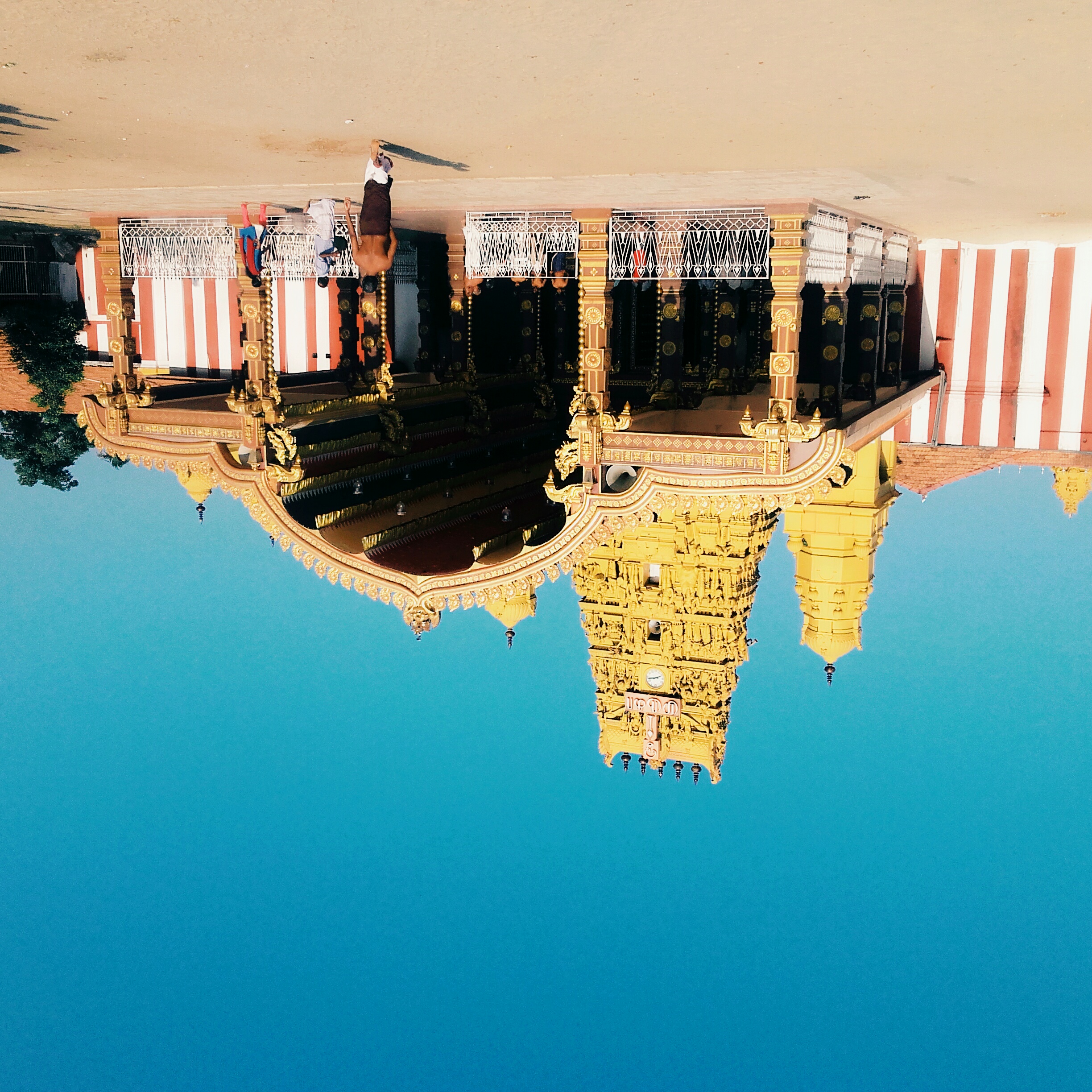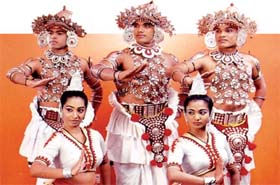|
Raban
Rоban or Rоbana (Sinhalese: රබාන) is one-sided traditional drum type played with the hands, used in Sri Lanka.Its mainly played in Aurudu Kreeda (The Srilankan New Year). The body of these drums are made by carving the Jack or Vitex trees. The skin used is that of a goat. There are two types of Robans as Hand Roban and Bench Roban. * Hand Roban is about one foot in diameter. Some performers keep revolving the Roban on the tip of their fingers while others play it accompanied with singing. This is played with one hand only. This type of Robana is mostly associated with the type of folk songs called 'Virindu'. The 'Virindu' singer carrying a 'Hand Robana' clad with a sarong and a bandana is an iconic in pre-modern Sri Lankan society. * Bench Roban is the biggest of the drums used in Sri Lanka with the diameter of it about four feet. The special feature of this drum is that it is played by two or more people at a time. They use both hands. During the festival season, peop ... [...More Info...] [...Related Items...] OR: [Wikipedia] [Google] [Baidu] |
Hand Drums
A hand drum is any type of drum that is typically played with the bare hand rather than a stick, mallet, hammer, or other type of beater. Types The following descriptions allude to traditional versions of the drums. Modern synthetic versions are available for most if not all of the drums listed through various manufacturers. Middle and Near East *The tar is a frame drum common in Middle Eastern music. *The tambourine is a frame drum with jingles attached to the shell. *The daf and the dayereh are Iranian frame drums. *The ghaval is the Azerbaijani frame drum. *The tonbak is the Persian goblet drum. *The doumbek is a goblet shaped drum used in Arabic, Jewish, Assyrian, Persian, Balkan, Greek, Armenian, Azeri and Turkish music. * Mirwas Africa *The most common African drum known to westerners is the djembe, a large, single-headed drum with a goblet shape. *The Ashiko is another African drum in the shape of a truncated cone. Similar to the Djembe it is rope strung. This drum is ea ... [...More Info...] [...Related Items...] OR: [Wikipedia] [Google] [Baidu] |
Sinhalese Language
Sinhala ( ; , ''siṁhala'', ), sometimes called Sinhalese (), is an Indo-Aryan language primarily spoken by the Sinhalese people of Sri Lanka, who make up the largest ethnic group on the island, numbering about 16 million. Sinhala is also spoken as the first language by other ethnic groups in Sri Lanka, totalling about 2 million people as of 2001. It is written using the Sinhala script, which is a Brahmic script closely related to the Grantha script of South India. Sinhala is one of the official and national languages of Sri Lanka. Along with Pali, it played a major role in the development of Theravada Buddhist literature. The early form of the Sinhala language, is attested as early as the 3rd century BCE. The language of these inscriptions with long vowels and aspirated consonants is a Prakrit similar to Magadhi, a regional associate of the Middle Indian Prakrits that has been used during the time of the Buddha. The closest relatives are the Vedda language (an endangered, i ... [...More Info...] [...Related Items...] OR: [Wikipedia] [Google] [Baidu] |
Sri Lanka
Sri Lanka (, ; si, ශ්රී ලංකා, Śrī Laṅkā, translit-std=ISO (); ta, இலங்கை, Ilaṅkai, translit-std=ISO ()), formerly known as Ceylon and officially the Democratic Socialist Republic of Sri Lanka, is an island country in South Asia. It lies in the Indian Ocean, southwest of the Bay of Bengal, and southeast of the Arabian Sea; it is separated from the Indian subcontinent by the Gulf of Mannar and the Palk Strait. Sri Lanka shares a maritime border with India and Maldives. Sri Jayawardenepura Kotte is its legislative capital, and Colombo is its largest city and financial centre. Sri Lanka has a population of around 22 million (2020) and is a multinational state, home to diverse cultures, languages, and ethnicities. The Sinhalese are the majority of the nation's population. The Tamils, who are a large minority group, have also played an influential role in the island's history. Other long established groups include the Moors, the Burghers ... [...More Info...] [...Related Items...] OR: [Wikipedia] [Google] [Baidu] |
Jack (tree)
''Mangifera caesia'' is a species of flowering plant in the cashew family, Anacardiaceae. Known in English as jack or white mango, among other names. It belongs to the same genus as the mango and is widely cultivated in areas of Indonesia, Malaysia, Singapore, Brunei, Papua New Guinea and the Philippines. It was featured in Malaysian stamp, printed in 1999 as a postage stamp in the rare fruits series. Names ''M. caesia'' is locally known as binjai (Malay language), wani ( Balinese language/Dusun language), yaa-lam ( Thai language), bayuno/baluno/belunok (Filipino language), mangga wani (Cebuano language/Sabah language), and gwani (Subanen language). Description These are restricted to wet lowlands at below 450m. It requires rainfall and is rarely in found forests but rather abundant in marshes and riverside areas. Grows up to tall with a dense crown of round-shaped leaves. The flowers are purple or pink, 0.7 cm long with five sepals. The fruit is a large, edible, elliptic ... [...More Info...] [...Related Items...] OR: [Wikipedia] [Google] [Baidu] |
Vitex
''Vitex'' is a genus of flowering plants in the sage family Lamiaceae.List of Genera in Lamiaceae. At: Peter F. Stevens. 2001 onwards. Angiosperm Phylogeny Website At: Missouri Botanical Garden Website. (see ''External links'' below). It has about 250 species.Raymond M. Harley, Sandy Atkins, Andrey L. Budantsev, Philip D. Cantino, Barry J. Conn, Renée J. Grayer, Madeline M. Harley, Rogier P.J. de Kok, Tatyana V. Krestovskaja, Ramón Morales, Alan J. Paton, and P. Olof Ryding. 2004. "Labiatae" pages 167-275. In: Klaus Kubitzki (editor) and Joachim W. Kadereit (volume editor). ''The Families and Genera of Vascular Plants'' volume VII. Springer-Verlag: Berlin; Heidelberg, Germany. ''Vitex'' In: Index Nominum Genericorum. In: Regnum Vegetabile (see ''External links'' below). Common names include chaste tree or chastetree, traditionally referring to '' V. agnus-castus'', but often applied to other species, as well. Species of ''Vitex'' are native throughout the tropics and subtrop ... [...More Info...] [...Related Items...] OR: [Wikipedia] [Google] [Baidu] |
Goat
The goat or domestic goat (''Capra hircus'') is a domesticated species of goat-antelope typically kept as livestock. It was domesticated from the wild goat (''C. aegagrus'') of Southwest Asia and Eastern Europe. The goat is a member of the animal family Bovidae and the tribe Caprini, meaning it is closely related to the sheep. There are over 300 distinct breeds of goat.Hirst, K. Kris"The History of the Domestication of Goats".''About.com''. Accessed August 18, 2008. It is one of the oldest domesticated species of animal, according to archaeological evidence that its earliest domestication occurred in Iran at 10,000 calibrated calendar years ago. Goats have been used for milk, meat, fur, and skins across much of the world. Milk from goats is often turned into goat cheese. Female goats are referred to as ''does'' or ''nannies'', intact males are called ''bucks'' or ''billies'', and juvenile goats of both sexes are called ''kids''. Castrated males are called ''wethers''. Whil ... [...More Info...] [...Related Items...] OR: [Wikipedia] [Google] [Baidu] |
Sarong
A sarong or sarung () is a large tube or length of fabric, often wrapped around the waist, worn in Southeast Asia, South Asia, Western Asia, Northern Africa, East Africa, West Africa, and on many Pacific islands. The fabric often has woven plaid or checkered patterns, or may be brightly colored by means of batik or ikat dyeing. Many modern sarongs have printed designs, often depicting animals or plants. Different types of sarongs are worn in different places in the world, notably the lungi in the Indian subcontinent and the izaar in the Arabian Peninsula. Etymology The term ''sarong'' () is an English loanword of Malay origin meaning 'to cover' or 'to sheath'. It was first used in 1834 referring to the skirt-like garment of the Malay. ''Sarong'' is also the colloquial and old spelling of the Indonesian and Malay word for , while in formal Indonesian it is known as ().Sarongis known in many names across Asia; including , ; , ; ; and . In West Africa, the word ''srong'' or '' ... [...More Info...] [...Related Items...] OR: [Wikipedia] [Google] [Baidu] |
Bandana
A kerchief (from the Old French ''couvrechief'', "cover head"), also known as a bandana, bandanna, or "Wild Rag" (in cowboy culture), is a triangular or square piece of cloth tied around the head, face or neck for protective or decorative purposes. The popularity of ''head kerchiefs'' may vary by culture or religion, often being used as a Christian headcovering by women of the Anabaptist, Eastern Orthodox, and Plymouth Brethren denominations, as well as by some Orthodox Jewish and Muslim women. The ''neckerchief'' and ''handkerchief'' are related items. Types Bandana A bandana or bandanna (from Sanskrit बन्धन or bandhana, "a bond") is a type of large, usually colourful kerchief, originating from the Indian subcontinent, often worn on the head or around the neck of a person. It is considered to be a hat by some. Bandanas are frequently printed in a paisley pattern and are most often used to hold hair back, either as a fashionable head accessory, or for practical purpo ... [...More Info...] [...Related Items...] OR: [Wikipedia] [Google] [Baidu] |
Culture Of Sri Lanka
The culture of Sri Lanka mixes modern elements with traditional aspects and is known for its regional diversity. Sri Lankan culture has long been influenced by the heritage of Theravada Buddhism passed on from India, and the religion's legacy is particularly strong in Sri Lanka's southern and central regions. South Indian cultural influences are especially pronounced in the northernmost reaches of the country. The history of colonial occupation has also left a mark on Sri Lanka's identity, with Portuguese, Dutch, and British elements having intermingled with various traditional facets of Sri Lankan culture. Additionally, Indonesian culture has also influenced certain aspects of Sri Lankan culture. Culturally, Sri Lanka possesses strong links to both India and Southeast Asia. The country has a rich artistic tradition, with distinct creative forms that encompass music, dance, and the visual arts. Sri Lankan culture is internationally associated with cricket, a distinct cuisine ... [...More Info...] [...Related Items...] OR: [Wikipedia] [Google] [Baidu] |
Kandyan Dance
Kandyan dance ( Sinhala: උඩරට නැටුම්) encompasses various dance forms popular and native to the area called Kandy of the Central Hills region known as Udarata in Sri Lanka, which have today spread to other parts of the country. It is an example of Sinhalese culture in Sri Lanka. History Ves Dance According to the legend, the origins of the dance lies in a dance ritual known as the '' Kohomba kankariya'' (named for the deity Kohomba), which is also known as ''Kohomba yak kankariya'' or simply ''kankariya''. Traditional dance masters believe that originally the king of a place referred to as "Malaya Rata", and his two brothers performed the first ''Kohomba kankariya''. Some believe that this "Malaya Rata" was located in India. According to legend, King Malaya came to the island as a result of a trick of the god Śakra in order to cure the king, Panduwasdev, who was suffering from a mysterious illness. The king was said to be suffering from a recurring drea ... [...More Info...] [...Related Items...] OR: [Wikipedia] [Google] [Baidu] |




.jpg)


